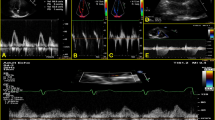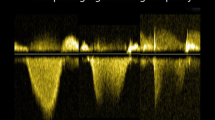Abstract
Purpose
Right heart catheterization (RHC) is the gold standard for the assessment of pulmonary artery systolic pressures (PASP). Despite high utilization of echocardiography for the non-invasive assessment of PASP, the data comparing real-time non-invasive echocardiographic PASP with invasive PASP is limited. Furthermore, evidence regarding the utility and diagnostic accuracy of ultrasound enhancing agents (UEA) for non-invasive PASP assessment is lacking. To evaluate the accuracy of non-invasive PASP assessment with real-time invasive measures and the incremental benefit of UEA in this setting.
Methods
This was a prospective cohort study of 90 patients, undergoing clinically indicated RHC for hemodynamic assessment. All patients underwent a limited echocardiogram during RHC. Tricuspid regurgitant velocity (TRV) was measured on unenhanced echo, in the setting of centrally administrated agitated saline, then as either centrally administered or peripherally administered UEA.
Results
Of the 90 patients enrolled in our study, 41% had pulmonary hypertension. The overall mean PASP measured by RHC was 32.8 mmHg (+/- 11.3 mmHg). Unenhanced echocardiograms had a moderate correlation with invasive PASP (r = 0.57; p = < 0.001) which improved to a strong correlation with administration of agitated saline (r = 0.75; p = < 0.001) or centrally administered UEA (r = 0.77; p = < 0.001), with the best correlation noted with peripherally administered UEA (r = 0.83; p = < 0.001). Against invasive PASP, agitated saline enhanced PASP had the lowest bias (0.12mmHg; -15.6 to 15.8mmHg) when compared with all other non-invasive measures of PASP.
Conclusions
Unenhanced echocardiographic estimation of TRV was found to have a poorer correlation with invasively measured PASP when compared to agitated saline and centrally administered UEA. Agitated saline enhanced PASP demonstrated the lowest bias with invasive PASP when compared to other non-invasive measures of PASP.



Similar content being viewed by others
References
Rudski LG, Lai WW, Afilalo J, Hua L, Handschumacher MD, Chandrasekaran K et al (2010) Guidelines for the echocardiographic assessment of the right heart in adults: a report from the American Society of Echocardiography endorsed by the European Association of Echocardiography, a registered branch of the European Society of Cardiology, and the Canadian Society of Echocardiography. J Am Soc Echocardiogr 23(7):685–713 quiz 86 – 8
Le Tourneau T, Richardson M, Juthier F, Modine T, Fayad G, Polge AS et al (2010) Echocardiography predictors and prognostic value of pulmonary artery systolic pressure in chronic organic mitral regurgitation. Heart 96(16):1311–1317
Ghio S, Gavazzi A, Campana C, Inserra C, Klersy C, Sebastiani R et al (2001) Independent and additive prognostic value of right ventricular systolic function and pulmonary artery pressure in patients with chronic heart failure. J Am Coll Cardiol 37(1):183–188
Huston JH, Maron BA, French J, Huang S, Thayer T, Farber-Eger EH et al (2019) Association of mild echocardiographic pulmonary hypertension with mortality and right ventricular function. JAMA Cardiol 4(11):1112–1121
Bhatia S, Frantz RP, Severson CJ, Durst LA, McGoon MD (2003) Immediate and long-term hemodynamic and clinical effects of sildenafil in patients with pulmonary arterial hypertension receiving vasodilator therapy. Mayo Clin Proc. ;78(10):1207-13
Parasuraman S, Walker S, Loudon BL, Gollop ND, Wilson AM, Lowery C et al (2016) Assessment of pulmonary artery pressure by echocardiography-A comprehensive review. Int J Cardiol Heart Vasc 12:45–51
Rosenkranz S, Preston IR (2015) Right heart catheterisation: best practice and pitfalls in pulmonary hypertension. Eur Respir Rev 24(138):642–652
O’Leary JM, Assad TR, Xu M, Farber-Eger E, Wells QS, Hemnes AR et al (2018) Lack of a Tricuspid Regurgitation Doppler Signal and Pulmonary Hypertension by Invasive Measurement. J Am Heart Assoc. ;7(13)
Berger M, Haimowitz A, Van Tosh A, Berdoff RL, Goldberg E (1985) Quantitative assessment of pulmonary hypertension in patients with tricuspid regurgitation using continuous wave doppler ultrasound. J Am Coll Cardiol 6(2):359–365
Byrd BF 3rd, O’Kelly BF, Schiller NB (1991) Contrast echocardiography enhances tricuspid but not mitral regurgitation. Clin Cardiol 14(11 Suppl 5):V10–V14
Currie PJ, Seward JB, Chan KL, Fyfe DA, Hagler DJ, Mair DD et al (1985) Continuous wave Doppler determination of right ventricular pressure: a simultaneous doppler-catheterization study in 127 patients. J Am Coll Cardiol 6(4):750–756
Beppu S, Tanabe K, Shimizu T, Ishikura F, Nakatani S, Terasawa A et al (1991) Contrast enhancement of Doppler signals by sonicated albumin for estimating right ventricular systolic pressure. Am J Cardiol 67(13):1148–1150
Porter TR, Mulvagh SL, Abdelmoneim SS, Becher H, Belcik JT, Bierig M et al (2018) Clinical applications of Ultrasonic Enhancing agents in Echocardiography: 2018 American Society of Echocardiography Guidelines Update. J Am Soc Echocardiogr 31(3):241–274
Mulvagh SL, Rakowski H, Vannan MA, Abdelmoneim SS, Becher H, Bierig SM et al (2008) American Society of Echocardiography Consensus Statement on the clinical applications of Ultrasonic contrast agents in Echocardiography. J Am Soc Echocardiogr 21(11):1179–1201 quiz 281
Calliada F, Campani R, Bottinelli O, Bozzini A, Sommaruga MG (1998) Ultrasound contrast agents: basic principles. Eur J Radiol 27(Suppl 2):S157–S160
Maresca G, Summaria V, Colagrande C, Manfredi R, Calliada F (1998) New prospects for ultrasound contrast agents. Eur J Radiol 27(Suppl 2):S171–S178
Porter TR, Abdelmoneim S, Belcik JT, McCulloch ML, Mulvagh SL, Olson JJ et al (2014) Guidelines for the cardiac sonographer in the performance of contrast echocardiography: a focused update from the American Society of Echocardiography. J Am Soc Echocardiogr 27(8):797–810
Lang RM, Badano LP, Mor-Avi V, Afilalo J, Armstrong A, Ernande L et al (2015) Recommendations for Cardiac Chamber quantification by Echocardiography in adults: an update from the American Society of Echocardiography and the European Association of Cardiovascular Imaging. J Am Soc Echocardiogr 28(1):1–39e14
Humbert M, Kovacs G, Hoeper MM, Badagliacca R, Berger RMF, Brida M et al (2022) 2022 ESC/ERS guidelines for the diagnosis and treatment of pulmonary hypertension. Eur Heart J 43(38):3618–3731
Jeon DS, Luo H, Brasch AV, Nagai T, Miyamoto T, Mohsenifar Z et al (2003) Superiority of 10% air-10% blood-saline mixture for measuring the velocity of tricuspid regurgitation in patients with severe emphysema. J Am Soc Echocardiogr 16(8):867–870
Jeon DS, Luo H, Iwami T, Miyamoto T, Brasch AV, Mirocha J et al (2002) The usefulness of a 10% air-10% blood-80% saline mixture for contrast echocardiography: Doppler measurement of pulmonary artery systolic pressure. J Am Coll Cardiol 39(1):124–129
Platts DG, Vaishnav M, Burstow DJ, Craig CH, Chan J, Sedgwick JL et al (2017) Contrast microsphere enhancement of the tricuspid regurgitant spectral Doppler signal - is it still necessary with contemporary scanners? Int J Cardiol Heart Vasc 17:1–10
Call AM, King K, Pascoe G (2012) R. Impact of Echo-contrast (definity) to Enhance Spectral Doppler Tricuspid regurgitation signals. Heart Lung Circ. :S208–S9
Karlinsky KT, Ilovitsh T (2022) Ultrasound frequency mixing for enhanced contrast harmonic imaging of Microbubbles. IEEE Trans Ultrason Ferroelectr Freq Control 69(8):2414–2424
Bismuth M, Katz S, Rosenblatt H, Twito M, Aronovich R, Ilovitsh T (2022) Acoustically detonated Microbubbles coupled with low frequency insonation: multiparameter evaluation of low energy mechanical ablation. Bioconjug Chem 33(6):1069–1079
Testani JM, St John Sutton MG, Wiegers SE, Khera AV, Shannon RP, Kirkpatrick JN (2010) Accuracy of noninvasively determined pulmonary artery systolic pressure. Am J Cardiol 105(8):1192–1197
Farber HW, Foreman AJ, Miller DP, McGoon MD (2011) REVEAL Registry: correlation of right heart catheterization and echocardiography in patients with pulmonary arterial hypertension. Congest Heart Fail 17(2):56–64
Funding
This study was supported by a grant from GE HealthCare, and an unrestricted research grant from the Division of Cardiology, Department of Medicine, Northwestern University Feinberg School of Medicine.
Author information
Authors and Affiliations
Contributions
V.A., G.C., B.S., I.M. & K.M. analysed data and wrote the main manuscript; M.K., T.N. & B.K. collected data and helped create figures and reviewed final manuscript for editing. All authors reviewed manuscript.
Corresponding author
Ethics declarations
Disclosures
Kameswari Maganti, MD received research support from GE HealthCare, and Division of Cardiology, Department of Medicine, Northwestern University Feinberg School of Medicine. Bonnie Kane was supported by a GE healthcare grant during the study. All the other authors have no disclosures to report.
Competing interests
The authors declare no competing interests.
Additional information
Publisher’s Note
Springer Nature remains neutral with regard to jurisdictional claims in published maps and institutional affiliations.
Rights and permissions
Springer Nature or its licensor (e.g. a society or other partner) holds exclusive rights to this article under a publishing agreement with the author(s) or other rightsholder(s); author self-archiving of the accepted manuscript version of this article is solely governed by the terms of such publishing agreement and applicable law.
About this article
Cite this article
Appadurai, V., Kinno, M., Minga, I. et al. The value of ultrasound enhancing agents in the echocardiographic acquisition of pulmonary artery systolic pressure: An invasive to non-invasive correlation study. Int J Cardiovasc Imaging 40, 821–830 (2024). https://doi.org/10.1007/s10554-024-03051-9
Received:
Accepted:
Published:
Issue Date:
DOI: https://doi.org/10.1007/s10554-024-03051-9




